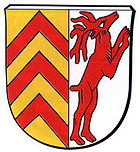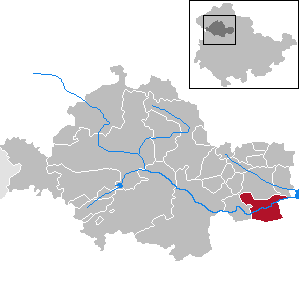Autumn life
| coat of arms | Germany map | |
|---|---|---|

|
Coordinates: 51 ° 7 ' N , 10 ° 50' E |
|
| Basic data | ||
| State : | Thuringia | |
| County : | Unstrut-Hainich district | |
| Fulfilling municipality : | for large vargula | |
| Height : | 169 m above sea level NHN | |
| Area : | 25.07 km 2 | |
| Residents: | 2924 (Dec. 31, 2019) | |
| Population density : | 117 inhabitants per km 2 | |
| Postal code : | 99955 | |
| Area code : | 036041 | |
| License plate : | UH, LSZ, MHL | |
| Community key : | 16 0 64 022 | |
| LOCODE : | DE ZRB | |
| Address of the municipal administration: |
Main street 52 99955 Herbsleben |
|
| Website : | ||
| Mayor : | Reinhard Mascher ( CDU ) | |
| Location of the Herbsleben community in the Unstrut-Hainich district | ||
Herbsleben is a municipality in the Unstrut-Hainich district in Thuringia .
geography
Geographical location
The community is located on the Unstrut and the Unstrut cycle path , which separates from the river in an eastward direction and continues to Gebesee .
Community structure
The districts of the municipality are:
- Autumn life
- Small vargula
Herbsleben is a fulfilling community for Großvargula .
climate
The community lies in the rain shadow of the Thuringian Forest and the Harz Mountains . Therefore the amount of precipitation of only approx. 480 mm per year is very low in the long-term average. The annual average temperature is 8.7 ° C.
history
The Chronicle
The history of the market town Herbsleben by Heinrich Zeyß PDF file offers a knowledgeable overview of the time between 530 and 1872, with archival material that is partly lost today. In Herbsleben the book is referred to as "the chronicle".
Early history
The place was first mentioned in 780 with the name "Herefridesleiben". A moated castle originally stood on the site of the castle that was demolished in 1958. It served to secure the surrounding area and a crossing over the Unstrut, which was part of a trade route that led from the Harz via Nordhausen to Arnstadt and across the Thuringian Forest.
12th century to the first half of the 16th century
In 1144 a "Heinrich Herverisleyben" (Herbsleben) was mentioned in a document from the Archbishop of Mainz. The lower mill in Herbsleben was mentioned between 1296 and 1327 under Albert von Herversleiben as a fief of the Counts of Henneberg . After that began changing ownership: In 1351 the Landgraves of Thuringia acquired the feudal sovereignty over the castle and place "Herbisleybin" from the Hennebergers from the House of Wettin . The Knights of Herbsleben were mentioned for the last time in 1424. In the Treaty of Leipzig the Wettin possessions in 1485 the place went to the Duchy of Saxony of Albertine . The Reformation was introduced in 1539 under Duke Heinrich the Pious as feudal lord over Herbsleben . After the defeat of the Ernestines in the Schmalkaldic War in 1547, Herbsleben continued to belong to the Albertine state territory, which was now called the Electorate of Saxony .
Second half of the 16th century to the 19th century
In 1554, in the Naumburg Treaty, Elector August ceded the office of Herbsleben to the Ernestine line of the Wettins without the city of Tennstedt . In the same year Bernhard von Mila , commander of Grimmenstein Castle near Gotha, took over the office and the Herbsleben Castle by buying it . In 1589 the sovereigns sold the Herbsleben estate to Hans and Wilhelm von Kerstlingerode. In 1554 the reconstruction of the castle began, which was completed between 1594 and 1600. The castle was destroyed as early as 1627 and immediately rebuilt. During the Thirty Years' War the castle and four other noble residences, the lower mill, the community tavern and 136 farmhouses and stables burned down. From 1640 Herbsleben belonged to the Duchy of Saxe-Gotha after several divisions of the Ernestine Duchies and from 1672 to the Duchy of Saxe-Gotha-Altenburg . The place was almost completely surrounded by the area of the Electorate of Saxony (Ämter Langensalza and Weißensee in the west, north and east) and the Electoral Mainz State of Erfurt (in the south); Herbsleben only bordered on the Duchy of Saxony-Gotha in the south-west of Tonna ( Döllstädt ).
In 1647 Duke Ernst the Pious sold the place to the von Carlowitz family as an inheritance. The castle was rebuilt by 1657. In 1709 the Herbsleben office and castle were acquired by the brothers Jacob Wilhelm and Georg von Forstern, whose descendants sold the castle and the estate to Finance Councilor Menz and banker Höfling from Fulda in 1810. From 1817 Mr. Menz was the sole owner. From this the estate came to the Landgrave of Hesse-Rotenburg in 1823 and to his brother-in-law, Prince Franz Josef von Hohenlohe-Schillingsfürst in 1829 . From 1847 the Dukes of Ratibor owned the castle.
In the course of the bourgeois revolution in 1848 , the right of patronage over Herbsleben passed to the community, the feudal lordship was abolished and the property was leased to Herbsleben residents. The Duchy of Saxony-Coburg and Gotha , to which Herbsleben had belonged since 1826, was divided into independent cities and district offices in 1858. Herbsleben was subordinated to the Gotha District Office in administrative tasks and to the Tonna District Court in judicial tasks .
20th century to the present
Herbsleben Castle came into the possession of Oskar Becker in 1907, who set up a restaurant in the building. From 1918 Herbsleben belonged to the Free State of Saxony-Gotha , which in 1920 became part of the State of Thuringia . With the administrative reform in the state of Thuringia, the place came to the district of Gotha in 1922 and after the district reform in the GDR in 1952 to the district of Langensalza in the district of Erfurt . In 1958 the intact castle was demolished.
Herbsleben belonged again to the Free State of Thuringia since 1990 with the Bad Langensalza district renamed in the same year . During the district reform in Thuringia , Herbsleben and the Bad Langensalza district became part of the new Unstrut-Hainich district on July 1, 1994 .
politics
Municipal council
The council of the Herbsleben community consists of 14 councilors and councilors. Since the local elections on May 26, 2019 , it has been composed as follows:
mayor
The full-time mayor Reinhard Mascher (CDU) was re-elected for his second term on April 15, 2018.
coat of arms
Blazon : “split; on the right in gold three red rafters one above the other, on the left in silver a red stag leaping to the left ”.
Economy and Infrastructure
economy
Along with Gierstädt and Kutzleben, Herbsleben is one of the most important asparagus centers in Thuringia.
traffic
Herbsleben station was on the Ballstädt – Straussfurt railway line . Passenger traffic ended in 1997; it was shut down in 1999 .
Culture and sights
Finds from the Bronze and Hallstatt Ages
- South of the place on the Erfurter Höhe is the site of a Bronze Age hoard. It is probably a ritually laid treasure.
- Metal finds from Hallstatt times were recovered in a burial mound on the Gallows Hill in the district of Herbsleben. It was therefore possible to conclude that there were subsequent burials from the Early Iron Age.
Museums
- Local history museum, with exhibits from the region
Castle ruin
One of the main attractions of Herbsleben is the castle ruins. It is a castle complex that was demolished in 1958.
( See main article: → Herbsleben castle ruins ).
St. Trinity Church
One of the sights of the place is the parish church of St. Trinitatis. It is a center of attraction for many visitors and is designated as a cycling church. ( See main article → St. Trinity (autumn life) ).
Events
For about 130 years there has been a festival on Whitsunday Saturday, during which the autumn liver Whitsun boys go to the Fahner Heights and cut two Whitsun trees there.
Sons and daughters of the church
- Hans Christoph Scherer (1582–1632), bailiff and diplomat
- Valentin Thau (1531–1575), mathematician, astronomer, philosopher and lawyer, professor at the University of Leipzig
- Heinrich Albert Zachariä (1806–1875), lawyer and politician
- Lothar Beck (* 1953), painter, sculptor and university professor
Individual evidence
- ^ Population of the municipalities from the Thuringian State Office for Statistics ( help on this ).
- ↑ History of the market town Herbsleben, by Dr. Heinrich Zeyß, (with a coat of arms) . Verlag der Thienemann'schen Hofbuchhandelung, Gotha 1873, reprint: ISBN 978-3-86777-268-6 , digital copy : PDF of SLUB Dresden
- ^ On the Naumburg Treaty: Carl Friedrich Göschel : Chronicle of the city of Langensalza in Thuringia. Volume 2. sn, sl 1818, p. 207 f.
- ^ The Tonna Justice Office in the Thuringia Archives .
- ↑ Michael Köhler: Thuringian castles and fortified prehistoric and early historical living spaces. Jenzig-Verlag Köhler, Jena 2001, ISBN 3-910141-43-9 , p. 136.
- ↑ Law on the self-administration of municipalities and districts in the GDR (municipal constitution) of May 17, 1990 .
- ↑ City council election 2019 in Thuringia. Thuringian State Office for Statistics, accessed on July 6, 2019 .
- ↑ Michael Köhler: Pagan sanctuaries. Pre-Christian places of worship and suspected cult sites in Thuringia. Jenzig-Verlag Köhler, Jena 2007, ISBN 978-3-910141-85-8 , p. 178.
- ↑ Michael Köhler: Pagan sanctuaries. Pre-Christian places of worship and suspected cult sites in Thuringia. Jenzig-Verlag Köhler, Jena 2007, ISBN 978-3-910141-85-8 , pp. 135-136.
literature
- Reinhold Andert : The Tretenburg, Herbsleben and the Königsleutedörfer. In: Reinhold Andert: The Thuringian King's Short. Dingsda-Verlag, Querfurt 1995, ISBN 3-928498-45-2 .
- Reinhold Andert: The ring around Herbsleben. In: Reinhold Andert: The Franconian Rider. Dingsda-Verlag Querfurt, Leipzig 2006, ISBN 3-928498-92-4 .
- Rudolf Steuckardt, Karl E. Hecht: Herbsleben in Thuringia. Pictures from a hundred years. Self-published by the Herbsleben community, Herbsleben 1995, ISBN 3-9804424-0-3 .
- Rudolf Steuckardt: Herbsleben in Thuringia. Pictures from a hundred years. Part 2. Self-published by the Herbsleben community, Herbsleben 2000, ISBN 3-9804424-5-4 .
- Rudolf Steuckardt: Herbsleben in Thuringia. Pictures from a hundred years. Part 3. Self-published by the Herbsleben community, Herbsleben 2003, ISBN 3-9804424-8-9 .
- Rudolf Steuckardt: A collection of old and newer postcards from Herbsleben and the neighboring towns. Self-published by the Herbsleben community, Herbsleben 2005, ISBN 3-9804424-9-7 .
- Rudolf Steuckardt: Herbsleben in Thuringia. Pictures from a hundred years. Part 4: The village and its people in ancient scripts. Self-published by the author, Herbsleben 2007.
Web links
- Community website
- Local history on the homepage of the community Herbsleben. Archived from the original on July 14, 2014 ; accessed on December 17, 2019 .




